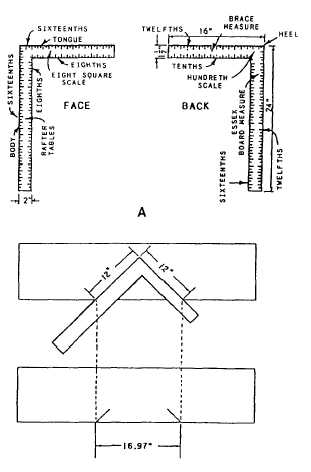rafter extending beyond the outer edge of the plate. A
measure line (fig. 2-4, view B) is an imaginary reference
line laid out down the middle of the face of a rafter. If a
portion of a roof is represented by a right triangle, the
measure line corresponds to the hypotenuse; the rise to
the altitude; and, the run to the base.
A plumb line (fig. 2-4, view C) is any line that is
vertical (plumb) when the rafter is in its proper position.
A level line (fig. 2-4, view C) is any line that is horizontal
(level) when the rafter is in its proper position.
FRAMING SQUARE
LEARNING OBJECTIVE: Upon completing
this section, you should be able to describe and
solve roof framing problems using the framing
square.
The framing square is one of the most frequently
used Builder tools. The problems it can solve are so
many and varied that books have been written on the
square alone. Only a few of the more common uses of
the square can be presented here. For a more detailed
discussion of the various uses of the framing square in
solving construction problems, you are encouraged to
obtain and study one of the many excellent books on the
square.
DESCRIPTION
The framing square (fig. 2-5, view A) consists of a
wide, long member called the blade and a narrow, short
member called the tongue. The blade and tongue form
a right angle. The face of the square is the side one sees
when the square is held with the blade in the left hand,
the tongue in the right hand, and the heel pointed away
from the body. The manufacturer’s name is usually
stamped on the face. The blade is 24 inches long and 2
inches wide. The tongue varies from 14 to 18 inches long
and is 1 1/2 inches wide, measured from the outer corner,
where the blade and the tongue meet. This corner is
called the heel of the square.
The outer and inner edges of the tongue and the
blade, on both face and back, are graduated in inches.
Note how inches are subdivided in the scale on the back
of the square. In the scales on the face, the inch is
subdivided in the regular units of carpenter’s measure
(1/8 or 1/16 inch). On the back of the square, the outer
edge of the blade and tongue is graduated in inches and
twelfths of inches. The inner edge of the tongue is
graduated in inches and tenths of inches. The inner edge
of the blade is graduated in inches and thirty-seconds of
Figure 2-5.—Framing square: A. Nomenclature; B. Problem
solving.
inches on most squares. Common uses of the twelfths
scale on the back of the framing square will be described
later. The tenths scale is not normally used in roof
framing.
SOLVING BASIC PROBLEMS WITH THE
FRAMING SQUARE
The framing square is used most frequently to find
the length of the hypotenuse (longest side) of a right
triangle when the lengths of the other two sides are
known. This is the basic problem involved in
determining the length of a roof rafter, a brace, or any
other member that forms the hypotenuse of an actual or
imaginary right triangle.
Figure 2-5, view B, shows you how the framing
square is used to determine the length of the hypotenuse
of a right triangle with the other sides each 12 inches
long. Place a true straightedge on a board and set the
square on the board so as to bring the 12-inch mark on
2-4

